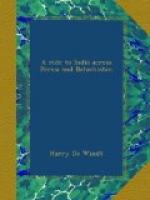The Persian port is cool and pleasant enough in winter-time, but in summer the stench from open drains and cesspools becomes unbearable, and Europeans (of whom there are thirty or forty) remove en masse to Sabsabad, a country place eight or ten miles off. The natives, in the mean time, live as best they can, and epidemics of cholera and diphtheria are of yearly occurrence. The water of Bushire producing guinea-worms (an animal that, unless rolled out of the skin with great care, breaks, rots, and forms a festering sore), supplies of it are brought in barrels from Bussorah or Mahommerah; but this is not within reach of the poorer class. Nearly every third person met in the street suffers from ophthalmia in some shape or other—the effect of the dust and glare, for there is no shade in or about the city.
The latter is built at the end of a peninsula ten miles in length and three in breadth, the portion furthest away from the town being swampy and overflowed by the sea. Most of the houses are of soft crumbling stone full of shells; some, of brick and plastered mud; but all are whitewashed, which gives the place the spurious look of cleanliness to which I have referred. The inhabitants of this “whited sepulchre” number from 25,000 to 30,000. There is a considerable trade in tobacco, attar of roses, shawls, cotton wool, etc.; but vessels drawing over ten feet cannot approach the town nearer than a distance of three miles—a great drawback in rough or squally weather.
Were it five thousand miles away, Bushire could scarcely be less like Persia than it is. It has but one characteristic in common with other cities—its ruins. Although of no antiquity, Bushire is rich in these. With this exception, it much more resembles a Moorish or Turkish city. The native population, largely mixed with Arabs, carries out the illusion, and bright-coloured garments, white “bournouses,” and green turbans throng the streets, in striking contrast to the sombre, rook-like garments affected by the natives of Iran. A stranger, too, is struck by the difference in the mode of life adopted by Europeans as compared with those inhabiting other parts of the Shah’s dominions. The semi-French style of Teheran and Shiraz is here superseded by the Anglo-Indian. Dejeuner a la fourchette, vin ordinaire, and cigarettes are unknown in this land of tiffins, pegs, and cheroots.
My recollections of Bushire are pleasant ones. The Residency is a large, rambling building, all verandahs, passages, and courtyards, faces the sea on three sides, and catches the slightest breath of air that may be stirring in hot weather. Two or three lawn-tennis courts, and a broad stone walk almost overhanging the waves, form a favourite rendezvous for Europeans in the cool of the evening. From here may be seen the Persian Navy at anchor, represented by one small gunboat, the Persepolis. This toy of the Shah’s was built by a German firm in 1885, and cost the Government over L30,000 sterling.




